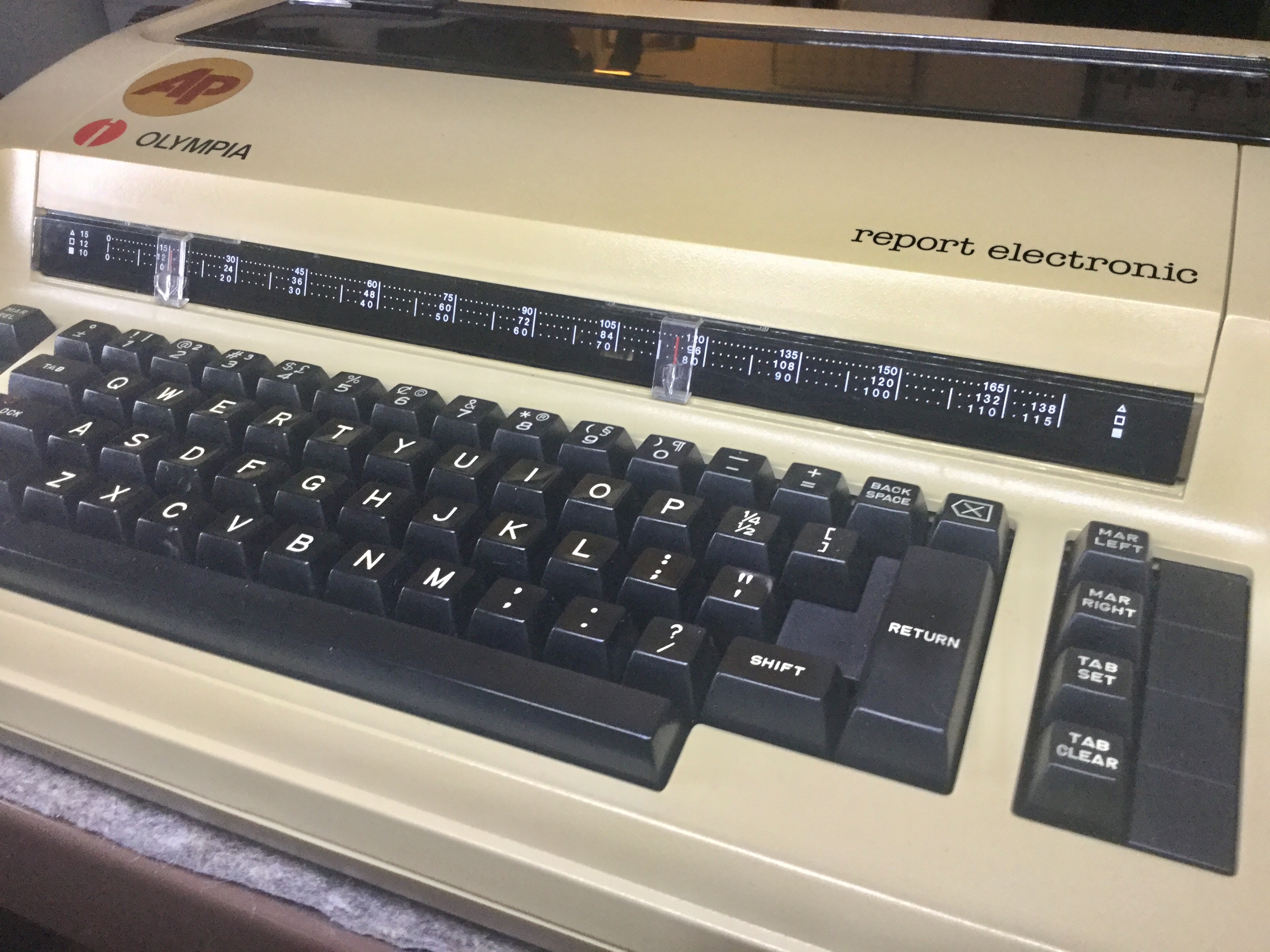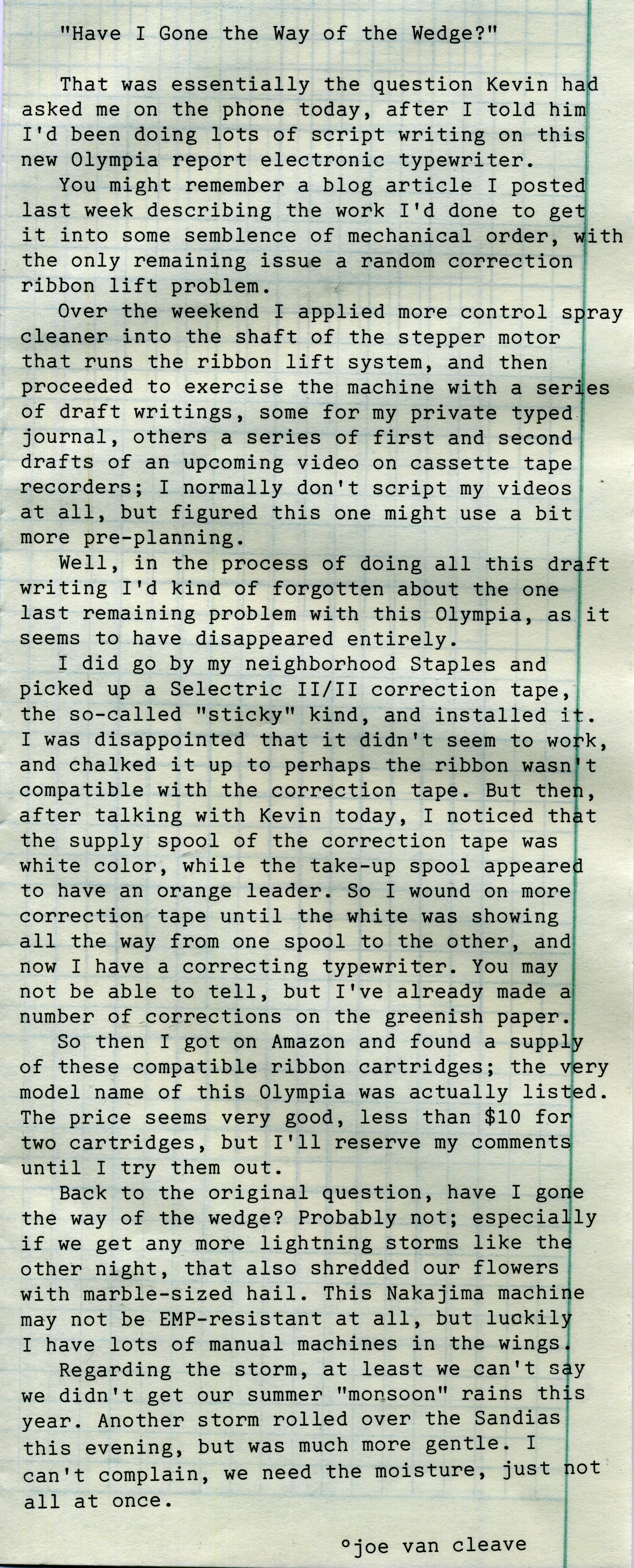Have I Gone the Way of the Wedge?


Post-Script: My assumptions about how the print wheel and ribbon motors worked, with encoders providing position feedback to the controller board, proved to be essentially correct, as by addressing their decades-old, oxidized connections seems to have done the trick. Every time I fix a difficult typewriter problem like what this machine had, I on the one hand congratulate myself, while on the other hand think of how long it took me to fix the problem, and that I'd never make a good typewriter repairman if I had to "put food on my family" while doing so. I'm a good tinkerer but would make a poor businessman.
Now that I have the correction tape properly installed and have sourced a supply for ribbons, I feel that this machine is finally back in business, as it was intended. I'm even more impressed with it now than what I expressed in the video earlier this week. After getting the correction system working, I found out it has enough memory to correct the entire current line, one letter at a time (but not the whole word erase or line erase functions of later machines). And you can skip around on that line, picking and choosing what letters to correct. Nice.
As for the keyboard itself, I'm typing this post-script using my 60% keyboard equipped with cherry MX brown mechanical switches, into my Mac mini. But that Olympia typewriter keyboard is almost as good, perhaps a bit softer. However, I'm using the typewriter on a small rolling typing table whose main surface is barely big enough for the girth of the Olympia, leaving no room for my forearms or wrists. I feel if it were placed on a proper desk, so I can support my arms better, it might be even more satisfying. I know for proper ergonomics a person is not supposed to plant their wrists; but I find it pretty comfortable with my computer keyboard setup, as I'm actually planting my entire forearms up to my elbows. Whatever works, right?
It's twenty till eleven PM (that's how we were taught to tell time "back in the day") and I'm suddenly thinking of doing a short video on how I fold typing paper in half lengthwise, to provide me a narrow text column for typing into my blog, while also making for an automatic backing sheet. Maybe. Either that, or get to sleep. Okay, until later.
Labels: daisywheel wedges, erasures, Olympia report electronic, Typewriter video series

6 Comments:
How much power do those generation of electronic typewriters really draw anyway? Especially assuming that it is nothing while idling you would think that It could continue to run on a UPS during a power outage eh?
The printed page is so clean - beautiful output. I can't see any of your corrections. I am tempted to try one of these electronic typewriters.
Gotta say one really nice thing about wedges is that there's basically zero collector interest in them, so you can get good ones either free or at the lunch-money price that mid-century manual portables used to go for before it all exploded. :D
I tried your trick of folding the paper in half today and used it to type up something on my 1899 Smith Premier 4. It worked nicely.
I have a Smith Corona daisy wheel typewriter. It was one of three others that came with my 1901 Smith Premier 4. The guy was trying to clean out his space. So, is that where the degree sign is coming from in your signature? Or does one of your manual machines have a degree sign on it?
Last year I picked up a black 15 inch Selectric III using the old II ribbons and got a whole mess of them with it as well. I have a few golf balls for it and have done some fun stuff with those. I mostly type of some stuff with the III, and I have too many Selectrics and a Silver-Reed copy too that are in disrepair.
My mom has a Smith-Corona wedge she bought for college back in the late 80's and ever since we dropped it has a hard time of turning on. Had some different wheels for it, small and light machine for what she needed it for.
Post a Comment
<< Home